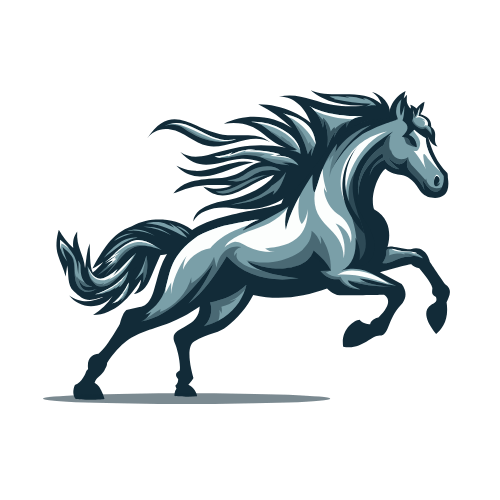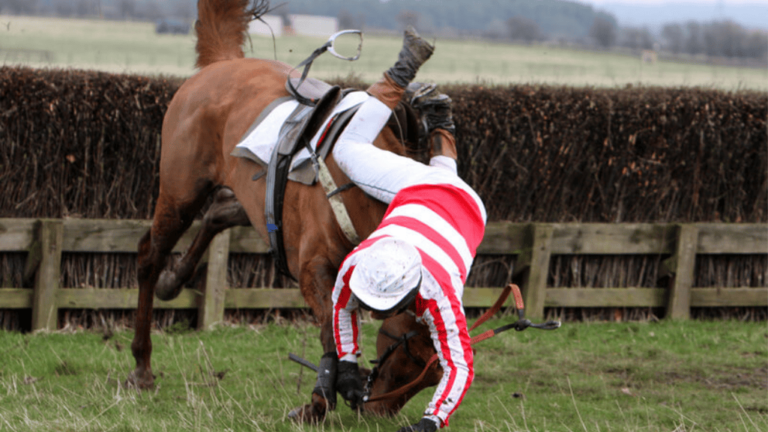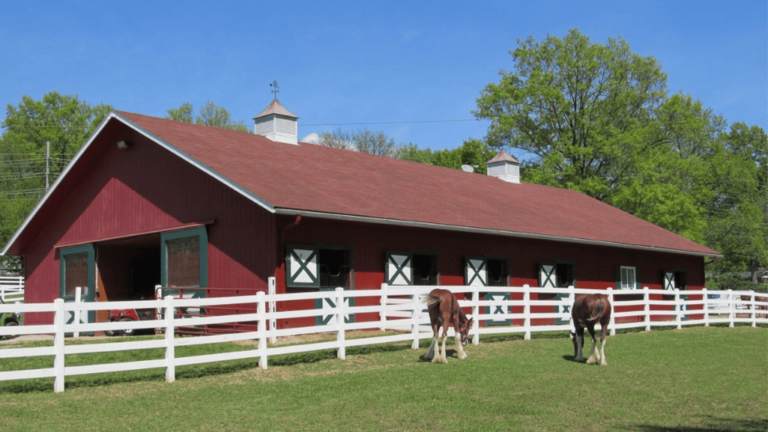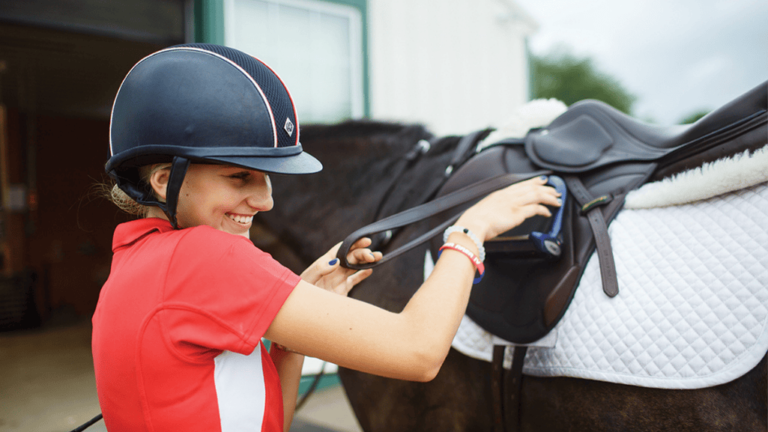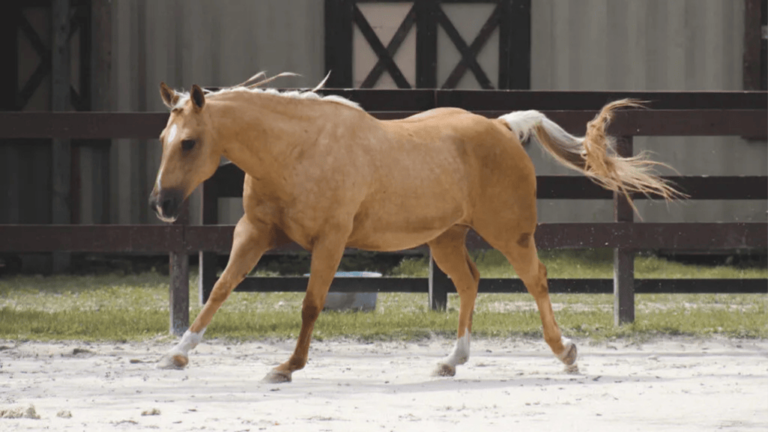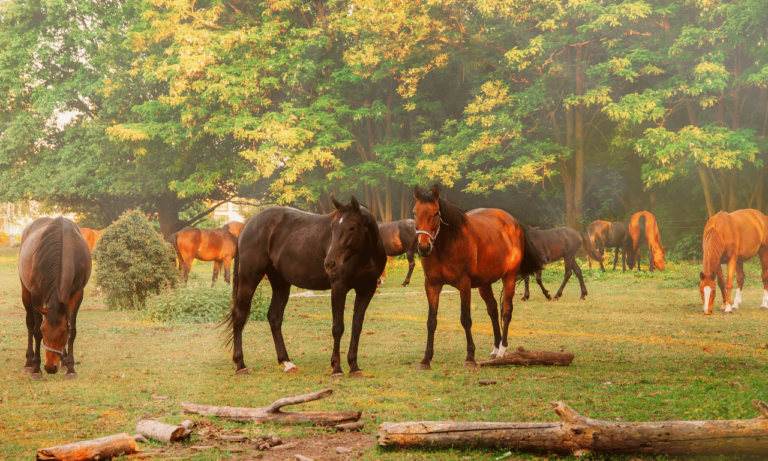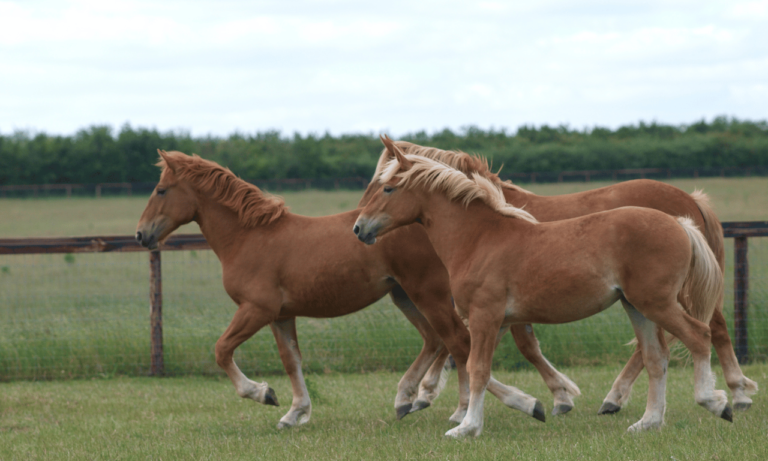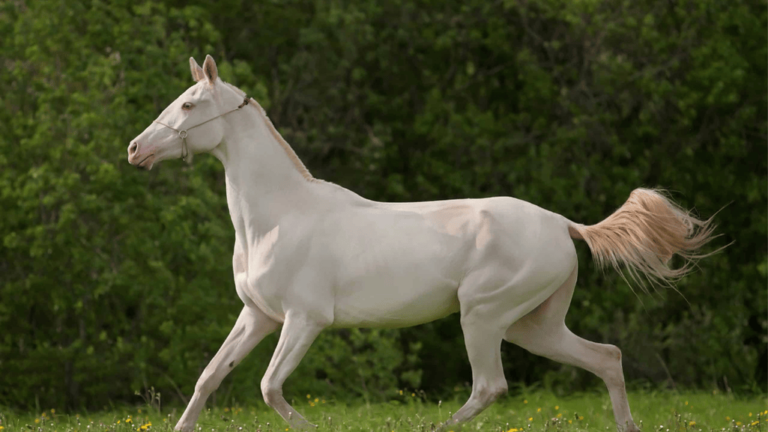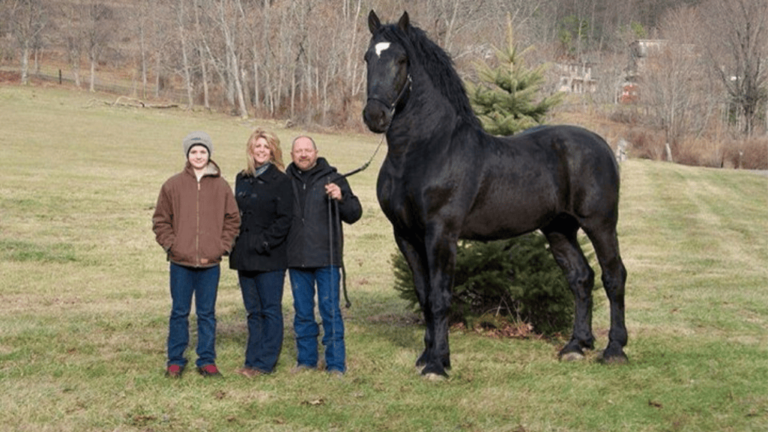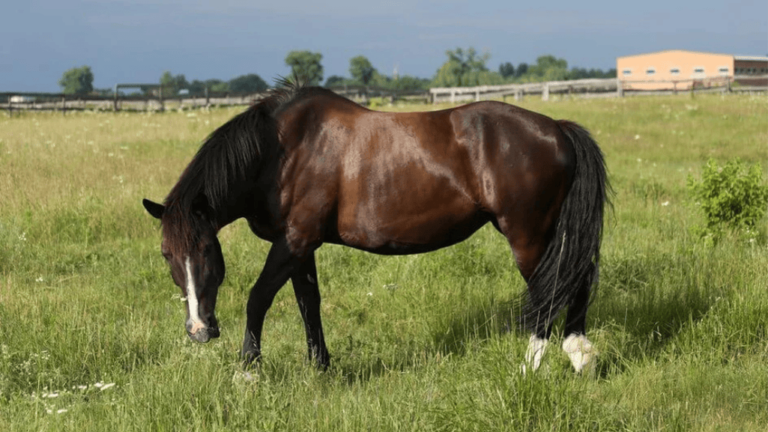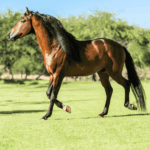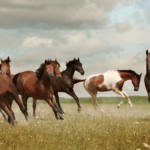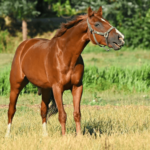Finding the right horse size is key for a good ride. It’s about comfort, balance, and safety. The right horse size matters a lot, especially for riders of different heights.
Things like the rider’s weight, height, and skill level are important. They need to match the horse’s size and build. This creates a perfect partnership.
Knowing about horse size for rider height is crucial. Even a small difference can affect the ride. Riders under 5’3″ often prefer taller horses, up to 14.3 hands.
This shows that taller riders can also find great matches. Horse sizes range from 13 to 15.2 hands. It’s not just about height, but also the horse’s spirit.
The horse’s build is more important than its height. The barrel size affects comfort and looks. It’s about finding the right fit, not just being tall.
Different riding styles require different horse sizes. In competitions, the look of the rider and horse is as important as their skills. They need to look good together.
Horses come in many sizes, from ponies to larger horses. They need the right clothes and blankets. This ensures they move freely and match the rider’s style.
Key Takeaways
- Choosing the ideal horse size for riders is a critical step for a safe and comfortable ride.
- Statistics indicate that riders under 5’4″ typically favor horses between 14.2 and 14.3 hands.
- The physical build of a horse, especially barrel size, can be more important than height in determining a good match.
- The horse’s body proportions and the rider’s physique should guide the selection process, rather than focusing on height alone.
- Preferences can vary greatly depending on the riding discipline, impacting the aesthetics of the rider-horse combination.
- Customization in gear such as blankets and hoods is essential to accommodate the vast range of horse sizes and proportions.
Understanding the Importance of Horse and Rider Matching
The right match between horse size and rider is key. It’s not just about looks; it’s about how well they work together. A good match means better control, balance, and fun for the rider. It also helps prevent overloading the horse and improves the rider’s skills.
Heavier riders need stronger horses for safety and comfort. Smaller riders do better with smaller horses for easier control. So, it’s important to check the horse’s build and how well it can carry weight.
| Horse Type | Height Range | Weight Range |
|---|---|---|
| Light Riding Horse | 14–16 hands (1.42–1.63m) | Varies significantly based on breed |
| Larger Riding Horse | 15.2–17 hands (1.57–1.73m) | Varies significantly based on breed |
| Heavy or Draft Horse | 16–18 hands (1.63–1.83m) | Usually heavier, supporting more weight |
| Shetland Pony | 7–10.2 hands (0.71–1.07m) | 180–200kg |
| Percheron | 16–18 hands (1.63–1.83m) | 850–950kg |
Matching horse size and rider proportions is complex. It involves looking at height, weight, and breed. This careful approach helps find the perfect horse for each rider. It keeps the horse healthy and ensures safe, enjoyable rides.
- Riding schools and pros check horses and tack yearly. They make sure everything fits the rider.
- Beginners need the right-sized horse to avoid accidents and stay balanced.
Understanding these factors helps riders make smart choices. It leads to a rewarding partnership between horse and rider. When matched well, riding is safer and more enjoyable for both.
Key Factors Affecting the Choice of Horse Size
When picking a horse, rider height is just one thing to think about. Other important factors like weight and riding experience also play a big role. The right horse size is key for safety, comfort, and clear communication between rider and horse.
Your Weight and the Impact on Horse Selection
A rider’s weight affects how well a horse can carry them. A good rule is for a horse to carry no more than 15-20% of its own weight. This includes the rider and any gear they’re wearing. For example, a 450 kg horse can carry 68-90 kg safely.
How Rider Height Shapes Your Horse Choice
Choosing a horse that matches your height is important for balance and control. Riders under 162 cm do well with horses around 142-152 cm tall. Those taller might need horses over 162 cm for a comfortable ride. This helps avoid discomfort and keeps the ride safe and fun.
Considerations for Age, Skill Level, and Future Ambitions
Age, skill level, and future plans also matter when picking a horse. Young or new riders might need a calm horse to learn on. More experienced riders might want a horse ready for competition. Matching the horse to the rider’s goals is crucial for success.
In summary, choosing the right horse size is about more than just height. It’s about making sure the horse and rider are both happy and can ride well together. It’s wise for riders to get advice from equestrian experts to make the best choice.
| Rider Height (cm) | Ideal Horse Height (cm) | Additional Recommendations |
|---|---|---|
| Under 162 | 142-152 | Choose lighter saddle, use safety stirrups like Ophena A |
| 162 – 178 | 152-162 | Ensure saddle fits properly, consider horse’s epaxial muscle development |
| Over 178 | Over 162 | Opt for horses with suitable thoracic dimensions to prevent muscle atrophy |
Understanding these factors helps riders make better choices when matching horse sizes to rider height. This ensures a safe and effective riding experience.
Horse Size for Rider Height What You Need to Know
Finding the right horse size for the rider’s height is key for safety and performance in equestrian sports. It’s important to know how these factors match up. This ensures a comfortable and effective partnership.
General Guidelines for Matching Horse Size to Rider Height
The horse size chart for riders is a basic guide. It helps find the ideal horse height based on the rider’s height. For example, a rider about 5’10” should match with a horse around 16 to 16.2 hands.
This rule helps riders find a size for easy control and better communication with the horse. It improves balance and reduces accident risks.
The Role of Horse Conformation in Rider Compatibility
A horse’s physical build, or conformation, greatly affects its suitability for riders. It must fit the rider’s leg length and body size comfortably. This is especially true in disciplines like eventing, where safety and precision are crucial.
Professional eventer William Fox-Pitt, who is very tall, often talks about the importance of matching horse conformation to rider height. This ensures better control and fewer faults or penalties.
When considering rider and horse sizes, weight-bearing capacity is also important. A typical horse can carry 15-20% of its body weight comfortably. For example, a lighter horse breed, like a connemara, is suitable for lighter or younger riders.
Larger breeds, like draft horses, are better for heavier riders. They can weigh up to 1,200 kg and stand 16-18 hands tall.
Knowing the horse size guide for riders and the natural abilities of different breeds is crucial. It helps make informed decisions for safety and efficiency. It also addresses issues where a horse might be too tall or too heavy for a rider, especially in advanced disciplines.
A proper match using a horse size chart for riders looks at more than just height. It also considers the horse’s conformation and weight-bearing abilities. This is key to choosing the right horse size for the rider’s height effectively.
This alignment is vital for a symbiotic relationship. It allows both horse and rider to perform at their best. It ensures safety and success in any equestrian discipline.
| Rider Height | Suggested Horse Height (Hands) | Typical Breed |
|---|---|---|
| 5’10” | 16 to 16.2 | Thoroughbred, Warmblood |
| 5’3″ | 14.2 to 15.2 | Connemara, Arabian |
Finding the Ideal Horse Size for Different Rider Heights
Choosing the right horse is all about matching the rider’s height to the horse’s size. Matching horse size to rider height makes riding more comfortable and effective. This part looks at the best horse sizes for tall and petite riders.
Suitable Horse Size for Tall Riders
Tall riders don’t always need the tallest horse. What’s key is the horse’s girth and build. A horse with a big barrel is stable and balanced, making it easier for the rider to sit comfortably.
This comfort helps with control and reduces strain on both the rider and the horse.
Best Horse Size for Short and Petite Riders
Short and petite riders do better with narrower, smaller horses. These horses help with leg contact, which is vital for giving clear riding cues. Plus, they’re closer to the ground, which can boost confidence for new or young riders.
It’s vital to consider the physical needs and limits of both the rider and the horse. Overloading a horse can harm its health, leading to issues like breathing problems and a slow pace. This is not just about the horse’s health but also the rider’s safety and success.
Here’s a detailed table that outlines the ideal horse weights for different rider weights. It shows how to match horse size to rider height perfectly:
| Rider Weight (kg) | Minimum Horse Weight (kg) | Maximum Horse Weight (kg) |
|---|---|---|
| 45 | 225 | 300 |
| 60 | 300 | 400 |
| 75 | 375 | 500 |
| 90 | 450 | 600 |
| 105 | 525 | 700 |
The Weight Carrying Capacity of Horses
Choosing the right horse for riding is crucial. It’s important to know the horse weight carrying capacity. This ensures the health and comfort of both the horse and rider. A general rule is that a horse can carry 15% to 20% of its body weight, including rider and gear.
For example, a 450 kg horse can carry between 68-90 kg. Knowing these limits can make riding better and prevent injuries to the horse.
It’s also important to know about horse rider weight chart specifics for certain breeds. Some breeds, like draft horses or sturdy ponies, can carry more than others. Understanding horse weight capacity for riders means knowing the breed’s needs and individual differences.
| Horse Type | Weight Capacity (kg) | Recommended Rider Weight (kg) |
|---|---|---|
| Light Riding Horse | 450 | 68-90 |
| Draft Horse | 900 | 135-180 |
| Connemara Pony | 350 | 52.5-70 |
Riders should talk to a vet or an experienced equestrian to find the right horse weight carrying capacity. This is important for fitting gear like saddles and stirrups. It helps keep balance and comfort during rides.
Using safety stirrups, like the Ophena A, adds extra safety. This is good for both the horse and rider.
With the right knowledge and advice, riders can have a safe and enjoyable ride. This makes their time in equestrian sports better.
How to Choose Horse Size According to Rider Height
When choosing horse size based on rider height, it’s important to match the rider’s height with the horse’s. This ensures a safe and balanced ride. If the rider feels too big or too small for their horse, it can be hard to control the horse.
Choosing the right horse size for a rider involves several factors. For example, William Fox-Pitt, a tall rider, shows that height isn’t everything. What’s more important is how well the rider fits on the horse and feels comfortable.
Here are some key things to think about when choosing horse height based on rider size:
- Rider comfort and balance are more important than the horse’s size.
- Choose a horse where the rider can easily get on and off.
- Make sure the rider can do all the necessary movements without straining.
Caroline’s daughter, who is 5’10”, rides a 16.1-hand horse. This size is good for her because it makes her feel stable and comfortable. It shows that choosing a horse should be based on how well it works for the rider, not just size.
Here’s a table that shows how these principles work in practice:
| Rider Height | Horse Height (hands) | Recommended for Discipline |
|---|---|---|
| 5’10” | 16.1 | General Riding, Dressage |
| 6’3″ (William Fox-Pitt) | Variable | Eventing, Show Jumping |
| 5’2″ | 14.1 | Reined Cowhorse |
This table shows that what’s most important is the rider’s comfort and the specific needs of their discipline. The right horse size is key for safety and enjoyment in riding.
In conclusion, while height and weight are important, they’re not the only things to consider. The best horse for a rider depends on their experience, the discipline they’re in, and the horse’s unique qualities. Whether you’re selecting the right horse size for a rider or looking at horse height based on rider size, finding the right balance is crucial for success.
Horse Size and Rider Proportions Explained
Understanding horse size and rider matching is key for the horse’s health and the rider’s safety. It involves looking at the horse’s height, barrel size, and the rider’s leg and torso size. This is more than numbers; it’s about finding harmony in proportions.
Riders say choosing a horse size that fits the rider is a detailed process. It’s about balancing leg length and torso sizes for comfort and safety. For example, many prefer horses around 15 to 16.2 hands tall for better equestrian performance.
| Horse Size (hands) | Rider Height (cm) | Preferred for Disciplines |
|---|---|---|
| 15.0 – 16.2 | 162 – 178 | General Riding/Equestrian |
| 16.3 – 17.2 | Over 178 | Equitation, Hunters |
| 14.0 – 15.0 | Under 162 | Competitive Sports |
The match between horse and rider can greatly impact performance, especially in competitions. Riders with longer legs might choose bigger horses for better balance. Those who are shorter might prefer narrower horses for easier control.
Good horse and rider proportions lead to better comfort, performance, and safety. With careful thought and expert advice, riders can find a horse that matches their size and riding goals.
A Detailed Look at Horse Size Chart for Riders
The horse sizing chart helps riders find the perfect horse. It considers the rider’s weight and height. This ensures a good match for a comfortable ride.
Interpreting the Horse Rider Weight Chart
Understanding the horse rider weight chart is key. It shows how weight affects horse size choice. For example, a 100 kg rider should look for horses weighing 500 to 600 kg.
This advice helps keep both horse and rider healthy. It ensures they work well together.
Horse Size Chart Versus Actual Horse and Rider Matching
The horse size to rider height ratio is important too. It helps both horse and rider perform well. It looks at more than just weight, like how they fit together.
Taller riders might need taller horses for a good ride. This keeps them comfortable and effective.
Real-world tests are better than charts. They show how horse and rider really work together. Sometimes, a shorter but sturdy horse is perfect for a rider, not what charts say.
Selecting a Horse Based on Rider Height: Practical Tips
Choosing a horse based on rider height is more than just looks. It’s about safety, comfort, and performance. Whether you’re into competitive riding or just enjoy leisurely rides, picking the right horse size is key. It ensures a good partnership between you and your horse.
Choosing the Right Horse Size: Hands-On Advice
To pick the right horse, consider the horse’s size and build. Horses can carry 15–20% of their body weight comfortably. So, a rider and saddle should match the horse’s weight. For example, a person weighing 88kg needs a horse between 500–666kg.
This balance is crucial for the horse’s health and your comfort. It also helps you control the horse better.
Height isn’t the only thing to think about. The horse’s build, like barrel width and neck length, affects how you fit. Test riding different horses helps you see how they match your height and weight. This hands-on approach gives you real insights. A horse’s weight-carrying ability and your height are key to avoiding strain on the horse and keeping you safe.
When to Opt for a Breed-Specific Horse Size
In some cases, choosing a breed-specific horse size is important. Larger breeds like draft horses can carry heavier riders. Smaller breeds or ponies are better for lighter or younger riders. The breed’s agility and temperament also matter, especially in disciplines like dressage or jumping.
For example, adults riding 15 hand horses might find it okay in certain disciplines. Riders over 6 feet tall have found comfort in 15.2 hand horses. So, considering breed-specific traits and individual horse characteristics is important when choosing based on rider height and riding style.
Ultimately, finding the right horse is about the ‘fit’. A well-suited horse makes riding comfortable, reducing injury risks and improving performance. It’s not just about size or breed. It’s about finding what works best for both the horse and rider, creating a partnership where both can thrive.
| Rider Height | Recommended Horse Size (hands) | Breed Consideration | Suitability |
|---|---|---|---|
| 5’7″ to 6’0″ | 15.3 to 17.1 | Varied | Ideal for general riding and competition |
| Over 6’0″ | 16.2 and above | Larger breeds like draft | Best for leisure and trail riding |
| Under 5’7″ | 14.2 to 15.2 | Lighter breeds or ponies | Good for sport and competitive riding |
In conclusion, choosing a horse based on rider height requires a holistic approach. It involves considering the rider’s needs, the horse’s capabilities, and the specific situations they’ll face together. With careful thought and practical testing, riders can find their perfect equine partner for a safe and enjoyable ride.
Conclusion
Finding the ideal horse size for rider height is all about the well-being of both the horse and the rider. There are many horse breeds and sizes, from the huge draft horses to the small Shetland ponies. Each size is perfect for different riders and riding styles.
Looking at Guinness World Records, like Big Jake and Sampson, shows us the amazing variety in horses. This variety means we need to use a horse size calculator for riders to find the right match.
For tall riders, horses over 162 cm are best. They offer a comfortable ride. Shorter riders do well with horses between 142-152 cm. It’s also important to consider the horse’s weight-carrying ability and the fit of the saddle and body protectors.
Choosing the right horse is a detailed process. It involves considering body weight and getting advice from trainers and saddle fitters. This journey leads to a rewarding partnership between rider and horse, built on respect and safety.
By following these tips, riders can create a harmonious partnership with their horses. This partnership brings elegance, grace, and mutual respect to the equestrian experience. It strengthens the bond between humans and horses.
